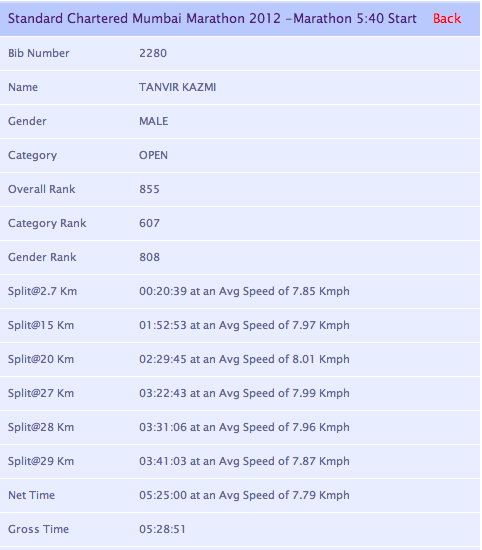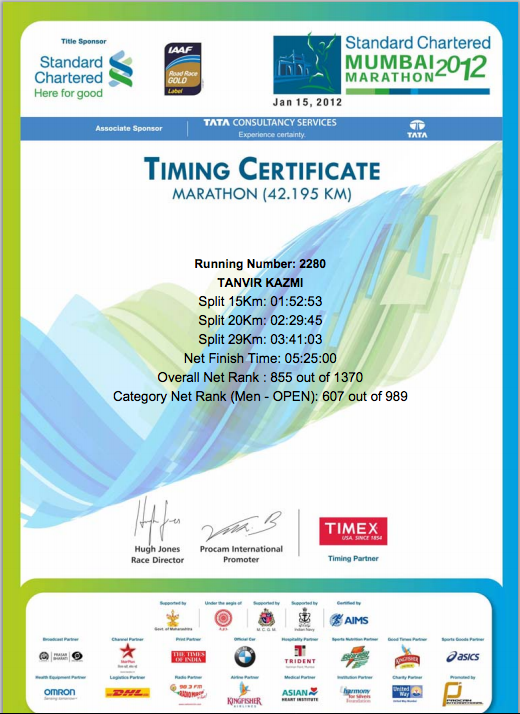I am the official pacer, or pace-setter for the 5:30 bus at the 2012 Mumbai Marathon. So, what does a pacer do and what is this ‘bus’ we are talking about?
My BIB#: 2280 | Starting group: C
What’s the Pacer’s job?
Whether you’re new to the 42.2KM marathon distance or a marathon veteran, you can join the Mumbai Marathon Pace Team for help with running a steady pace and achieving your race-day time goal. Each pace team leader is a seasoned and reliable marathoner who will offer coaching and support throughout the race. I am honored that Mumbai Marathon organizers have considered me for this role for the 5:30 finish.
Pace team leaders will run the marathon at an even pace, meaning that every KM will be run in approximately the same amount of time. The leaders will reach the half-marathon mark within two minutes (plus or minus) of the goal pace for the projected finishing time, and will finish the marathon no more than two minutes faster than the goal time, based on gun time. Runners will be encouraged to spread out to avoid overcrowding. As long as they keep their leader in sight, they will remain on pace.
A part of this article has been published in Mid-Day on Jan 11, 2012. Click on the below image to see the entire article.

What’s this ‘Bus’ thing?
This is not the bus that takes you from your home to Mumbai CST. Nor is this the bus that takes you to the start of the race. This is the so called “runners bus” that some runners opt to “hop” onto on route to the finish. A “bus” is a group of runners who run at a specified pace with the intention of finishing the race in a specified time. This group of runners are led by a “bus driver”, who in most instances will carry a flag indicating the intended finish time of the bus.
What are the Buses on offer at Mumbai Marathon?
There are three buses for the Mumbai Marathon, with target finish times of 4:30, 5:00 and 5:30 hours. Each team will comprise of 2 team leaders or pacers who will take the responsibility to reach the finish line within their target times. Please note that these finish times are the gun times and not the time calculated after you cross the starting line (which for a marathon with about 2500 runners may span 2-3 minutes or more).
Mumbai Marathon Route And Elevation
Please note that this year runners are expected to hit the sea link while going out rather than while coming back. So, you will go on to the sea link after reaching Worli and then come back around Bandra, Mahim, and Dadar sections. Start and finish remain at Mumbai CST. See more details on the 2012 route here.

Okay, come to the point about this 5:30 business
Hmm, sure. I was thinking about it too. Lets start with the finish time itself. 5 hours and 30 minutes finish time here is as per the gun time. So, even if we cross the starting line 2 minutes after the gun was fired due to the rush, the target would be to reach the finish line inside 5:30 of the gun being fired, so basically that 2 minutes lost due to the delay in reaching the starting line has to be covered up during the race.
Finding your pacer at the starting line
Ok, I got ahead of myself a bit and we need to go back to the start. How do you find your pacer to start with? I will be running with something on me which will clearly mention the target finish time as 5:30. It is expected to be a flag as I write, which people can notice from a distance and Amit Sheth (5:00 hour pacer) has been working on how to put up that flag on a runner. I know the starting point and the holding area is a chaotic place, so keep an eye on someone looking a bit out of place 🙂 Additional complications start with the A, B, C, D starting groups based on past finish times for runners and it gets more complicated since your group may be different from mine which means that the only way for you to catch me (or for me to catch you) is on the road. That will not be too difficult, believe me, I will run slow.
That’s all good, but what’s the Strategy?
Ok, sure. This is the fun part and which I like the most. Doing all the calculations to make sure everything just fits in well.
Finish time goal = 5:30 = 330 minutes
Distance to cover = 42.2KM
Pace required = 7:49 Mins/KM (7 minutes, 49 seconds per kilometer)
Note: Even though the pace required is 7:49, this does not mean we will be running at this pace continuously. There are water stops along the way where we will be stopping a bit, there are hills where we will be walking a bit. So, lets consider the average running pace we can expect for most of the race to be in the region of 7:15 min/km to 7:30 min/km. If we hit 21 water stops (one at every two km), we can potentially lose 30 seconds at each one of them (stopping, drinking, walking a bit) which makes it 10 mins. A 7:15 pace makes for a 5:06 finish time. A 7:30 pace makes for a 5:16 finish time. Add those 11 minutes and add 5 minutes extra for the hills, a couple of minutes for starting after gun time, and we are bang there in 5:30!
But that’s not all there is about pacing. We know we are stronger at the start, and as the Mumbai sun starts shining brightly, and the humidity is on the high, even the best of runners find the going tough. This means that for an average runner, it is expected that the second half will be slightly slower than the first half. It is only the best of runners under the best of conditions who can run an entire marathon under the same pace. So, what happens now to our strategy of running between that 7:15 min/km and 7:30 min/km? Well, we tweak it just a little bit!
Lets do the maths backwards. For a finish goal of 5:30, lets target a slightly faster finish goal for the first half and leave some time for the second half. Fair enough. So, if we do the first half (i.e. 21.1KM) in 2:40, we leave ourselves with 2:50 to do the next half.
First half in 2:40 = 7:34 min/km = about 7:15 running pace with water stops, etc
Second half in 2:50 = 8:03 min/km = about 7:45 running pace with water stops, etc
5KM – 38 mins (5K in 38 mins)
10KM – 1:16 hr (5K in 38 mins)
15KM – 1:54 hr (5K in 38 mins)
20KM – 2:32 hr (5K in 38 mins)
21.1KM – 2:40 hr (Halfway)
25KM – 3:12 hr (5K in 40 mins)
30 KM – 3:52 hr (5K in 40 mins)
35 KM – 4:32 hr (5K in 40 mins)
40 KM – 5:12 hr (5K in 40 mins)
42.2KM – 5:30 hr (Finish)
Since we have a 7:45 running pace to keep in the second half and we are targeting just a bit faster than this (basically between 7:30 and 7:40), we will hopefully be finishing just under the 5:30 mark.
Strategy on Water Stops and Hills
At every water stop, which are expected to be spread every 2 to 2.5KM, we will stop to pick up water, take a couple of sips, maybe grab a bottle if we think we need an extra one particularly in the second half to pour over our head or for an in between sip, and move on. The entire act of stopping, drinking a couple of sips of water, and walking a bit should not take more than 30 to 40 seconds.
Hills at Mumbai Marathon come during sections 6-11 KM (half gradually up, half down, see map and elevation chart above). When going out from CST this section is hit as soon as we leave Marine Drive and go onto the Malabar Hill stretch up onto Peddar Road and then down to Haji Ali. On the way back, this section comes between 33-38KM as we reach Haji Ali, climb onto Peddar Road and down to Marine Drive. In all, we are probably doing a 4KM climb which we will try to fast walk for most of the time. This will slow us down by about 3 mins in the first half and 3 mins in the second half, and will require minor adjustment to our running pace to keep ourselves on track.
Hmm, I thought pacing was simple, this sounds complicated
Not quite, but yes, it is a bit involved, and if you are doing your first marathon or wanting to improve your timings from last year, you would rather want to forget about all these minute details and just focus on your run. From my experience, even simple calculations become very difficult once you are into long distance. This is where pacers come it to help you out!
What should I eat, what should I drink (and what about those porta-potties)?
Ok, you want to play rough, fine. Every runner has different abilities to consume different amounts and types of food. Stick to what you have been doing in your long runs. If you find something easy to carry on the run (raisins, dates, gels, energy bars, chocolates) and you are used to it, do it. Don’t try anything new on race day. Maybe have some light food like sandwich or a banana before the race. Hydrate but don’t over-hydrate before the run, otherwise once you start running and your bladder starts troubling, firstly it would be difficult to find those endangered and rarely found species called porta-potties (or mobile toilets on the way), and secondly you will waste precious time in relieving yourself, nothing less than 2 mins if not more. Take a couple of sips from those small cups. Pour some over your head and back as things get hot later. Use a cap to keep your head and face protected from sun.
So, How good is a 5:30 finish?
Actually, 5:30 is really a great finish time for Mumbai Marathon. To give you a perspective, in 2011 about 1320 runners started the Mumbai Marathon, and only about 640 runners finished within 5:30, that is less than 50% of the field. 964 runners finished the marathon out of those 1320 runners, which means 5:30 finishers were in the top 66% of the finishers. Mumbai Marathon is one tough nut to crack, and doing a 5:30 run would be a great way of doing just that.
A little about me
I don’t claim to be a marathon veteran, but I do have a few years on the road. I have been running since 2005 and have done 10 marathons, 3 ultras and a few halfs in this time including 4 Mumbai Marathons. I have also run and finished the worlds largest ultramarathon – Comrades – an 89KM ultra in South Africa in 2010. You can check out some of my running experiences on my About page. My first Mumbai Marathon in 2006 was a really humbling experience. I did a 2:20 something by half way and feeling on top of the world. That world exploded at 28KM and it was mostly walking after that for a 5:55 finish. I do not want this to happen to any one of you running with me.
All the best. Never Give Up!



